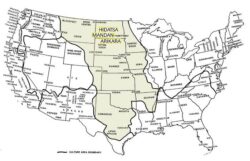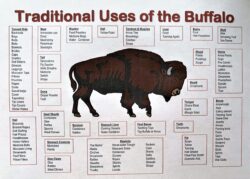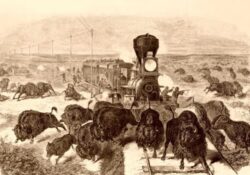Buffalo was the 7-11, Quick Mart, Truck Stop, and Town Pumps, for the first peoples and pioneers! These critters offered more than meat. The hides, bones, dung, and other parts were vital to the survival of plains peoples and the first pioneers. 
Once a Buffalo was down, hunters offered the meat to the community along with so many other benefits. Entire native cultures followed the herds of Buffalo to allow them to access the needs of the tribe. Hunting Buffalo was a ritual and celebration of their heritage and lives.
The first parts of the Buffalo to be used were often the heart and tongue. Both were incredibly healthy and tasty meals. The hunter that killed the beast was often the recipient of these treats. The children, women, and elders would often follow the hunt and immediately begin to dress, harvest, and shop for what was needed. The Medicine Man or healer would gather what was needed to maintain health products. These first aid needs were often immediately needed to help injured Buffalo hunters. Harvesting Buffalos with spears and arrows was no easy feat. 
Seasonal Buffalo Jump events were like a Black Friday shopping event. Hundreds of buffalo could be stampeded off a cliff to be used and processed. Healthy herds of Buffalo were never endangered by the hunting of native peoples or early pioneers. Arrows, spears, and muzzle loaders were not able to kill in vast quantities. Closed hunting seasons were not needed.
Perhaps the most useful part of the Buffalo was the hide. Skins meant clothing, leather, tipis, and protection from the harsh environment. Bladders became water carriers, fat became soap, blood became paint, bones became tools and weapons, hooves were now cups, rattles, spoons, and glue.
At one time, there were 50 million or more buffalo. Herds were so large that it took days to travel through them. Bison provided life to the plains people and predators for centuries. From 1850-1895, 50 million critters were whittled down to less than 1000.
As pioneers headed west, the native peoples resisted. The military minds figured that to get rid of the natives, get rid of their one stop shop. Hunting and irradicating buffalo were the solution to getting rid of the native peoples that depended upon them for survival.
The wave of civilization was a tsunami too large to survive. A market hunter with a more modern weapon could harvest over 250 buffalo a day. Bullets were way more fatal than arrows, spears, and cliffs. Trains were now access to the huge herds. Sport hunters paid to travel to the plains to shoot buffalo from the comfort of train cars. Hide, tongue, and meat hunters also targeted these herds. Soon, Buffalo were nearly dinosaurs. 
When the Smithsonian wanted Buffalos to taxidermy for their displays, it took 2 years to find any to shoot! Others came from eastern Montana, near Miles City. A calf found, was raised, and displayed for years until it died. Teddy Roosevelt managed to find some on the Harriman Ranch. These specimens are on display. There were a few dozen more still around so Roosevelt introduced them into Yellowstone Park. These buffalo are not the original species that once lived their but seem to have adjusted well.
Today, the Buffalo are making a steady comeback. Ranchers raise Buffalo for meat. Ted Turner has herds for this purpose to feed customers at his restaurants. Native peoples now have over 20,000 buffalo on their reservations. There are over 300,000 buffalo on other public and federal lands. Yellowstone Park has a population of nearly 5,000 critters a year. This is a far cry from the 50 million that once roamed our nation.
I wonder what would happen if we closed the Walmart’s and one stop shops of today. How would we get by? Where could we quickly buy milk and eggs? No more liquor stores? OMG! What could we do? Amazon is gone, no mail order anything, nothing made in Japan or China?
Perhaps there is a lesson here that we need to learn. Never take anything for granted.
Don’t get Buffaloed!
Montana Grant